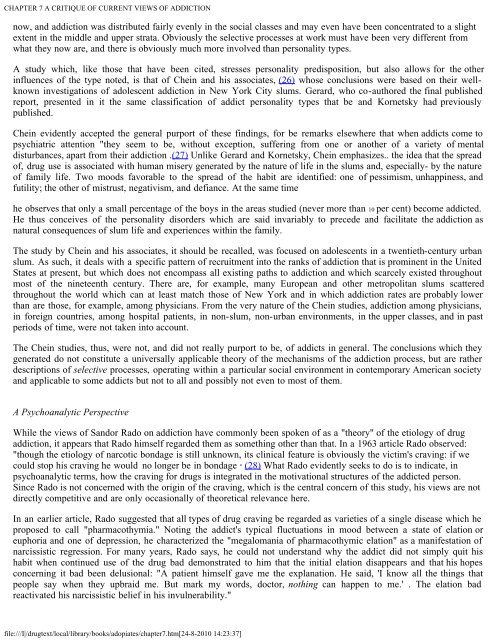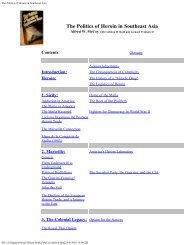Addiction and Opiates
Addiction and Opiates
Addiction and Opiates
Create successful ePaper yourself
Turn your PDF publications into a flip-book with our unique Google optimized e-Paper software.
CHAPTER 7 A CRITIQUE OF CURRENT VIEWS OF ADDICTION<br />
now, <strong>and</strong> addiction was distributed fairly evenly in the social classes <strong>and</strong> may even have been concentrated to a slight<br />
extent in the middle <strong>and</strong> upper strata. Obviously the selective processes at work must have been very different from<br />
what they now are, <strong>and</strong> there is obviously much more involved than personality types.<br />
A study which, like those that have been cited, stresses personality predisposition, but also allows for the other<br />
influences of the type noted, is that of Chein <strong>and</strong> his associates, (26) whose conclusions were based on their wellknown<br />
investigations of adolescent addiction in New York City slums. Gerard, who co-authored the final published<br />
report, presented in it the same classification of addict personality types that be <strong>and</strong> Kornetsky had previously<br />
published.<br />
Chein evidently accepted the general purport of these findings, for be remarks elsewhere that when addicts come to<br />
psychiatric attention "they seem to be, without exception, suffering from one or another of a variety of mental<br />
disturbances, apart from their addiction .(27) Unlike Gerard <strong>and</strong> Kornetsky, Chein emphasizes.. the idea that the spread<br />
of, drug use is associated with human misery generated by the nature of life in the slums <strong>and</strong>, especially- by the nature<br />
of family life. Two moods favorable to the spread of the habit are identified: one of pessimism, unhappiness, <strong>and</strong><br />
futility; the other of mistrust, negativism, <strong>and</strong> defiance. At the same time<br />
he observes that only a small percentage of the boys in the areas studied (never more than 10 per cent) become addicted.<br />
He thus conceives of the personality disorders which are said invariably to precede <strong>and</strong> facilitate the addiction as<br />
natural consequences of slum life <strong>and</strong> experiences within the family.<br />
The study by Chein <strong>and</strong> his associates, it should be recalled, was focused on adolescents in a twentieth-century urban<br />
slum. As such, it deals with a specific pattern of recruitment into the ranks of addiction that is prominent in the United<br />
States at present, but which does not encompass all existing paths to addiction <strong>and</strong> which scarcely existed throughout<br />
most of the nineteenth century. There are, for example, many European <strong>and</strong> other metropolitan slums scattered<br />
throughout the world which can at least match those of New York <strong>and</strong> in which addiction rates are probably lower<br />
than are those, for example, among physicians. From the very nature of the Chein studies, addiction among physicians,<br />
in foreign countries, among hospital patients, in non-slum, non-urban environments, in the upper classes, <strong>and</strong> in past<br />
periods of time, were not taken into account.<br />
The Chein studies, thus, were not, <strong>and</strong> did not really purport to be, of addicts in general. The conclusions which they<br />
generated do not constitute a universally applicable theory of the mechanisms of the addiction process, but are rather<br />
descriptions of selective processes, operating within a particular social environment in contemporary American society<br />
<strong>and</strong> applicable to some addicts but not to all <strong>and</strong> possibly not even to most of them.<br />
A Psychoanalytic Perspective<br />
While the views of S<strong>and</strong>or Rado on addiction have commonly been spoken of as a "theory" of the etiology of drug<br />
addiction, it appears that Rado himself regarded them as something other than that. In a 1963 article Rado observed:<br />
"though the etiology of narcotic bondage is still unknown, its clinical feature is obviously the victim's craving: if we<br />
could stop his craving he would no longer be in bondage " (28) What Rado evidently seeks to do is to indicate, in<br />
psychoanalytic terms, how the craving for drugs is integrated in the motivational structures of the addicted person.<br />
Since Rado is not concerned with the origin of the craving, which is the central concern of this study, his views are not<br />
directly competitive <strong>and</strong> are only occasionally of theoretical relevance here.<br />
In an earlier article, Rado suggested that all types of drug craving be regarded as varieties of a single disease which he<br />
proposed to call "pharmacothymia." Noting the addict's typical fluctuations in mood between a state of elation or<br />
euphoria <strong>and</strong> one of depression, he characterized the "megalomania of pharmacothymic elation" as a manifestation of<br />
narcissistic regression. For many years, Rado says, he could not underst<strong>and</strong> why the addict did not simply quit his<br />
habit when continued use of the drug bad demonstrated to him that the initial elation disappears <strong>and</strong> that his hopes<br />
concerning it bad been delusional: "A patient himself gave me the explanation. He said, 'I know all the things that<br />
people say when they upbraid me. But mark my words, doctor, nothing can happen to me.' . The elation bad<br />
reactivated his narcissistic belief in his invulnerability."<br />
file:///I|/drugtext/local/library/books/adopiates/chapter7.htm[24-8-2010 14:23:37]





